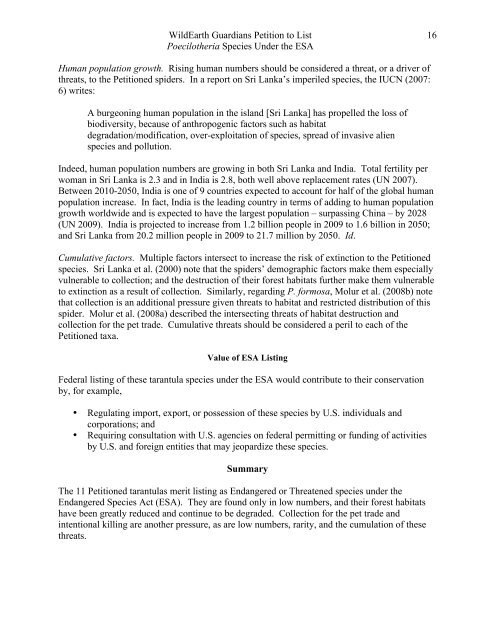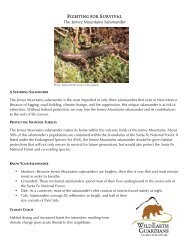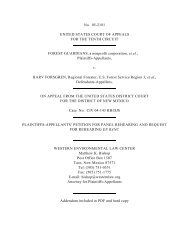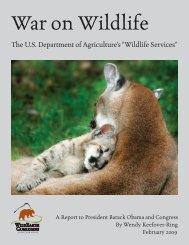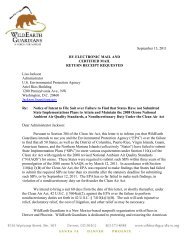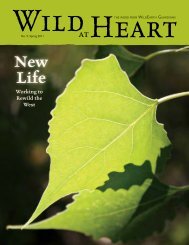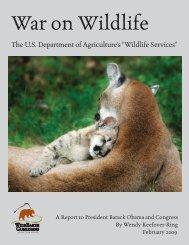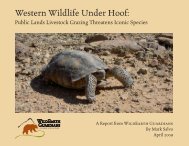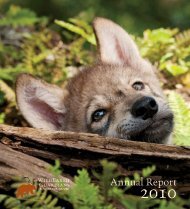Tarantulas Petition - WildEarth Guardians
Tarantulas Petition - WildEarth Guardians
Tarantulas Petition - WildEarth Guardians
Create successful ePaper yourself
Turn your PDF publications into a flip-book with our unique Google optimized e-Paper software.
<strong>WildEarth</strong> <strong>Guardians</strong> <strong>Petition</strong> to List<br />
16!<br />
Poecilotheria Species Under the ESA<br />
!<br />
Human population growth. Rising human numbers should be considered a threat, or a driver of<br />
threats, to the <strong>Petition</strong>ed spiders. In a report on Sri Lanka’s imperiled species, the IUCN (2007:<br />
6) writes:<br />
A burgeoning human population in the island [Sri Lanka] has propelled the loss of<br />
biodiversity, because of anthropogenic factors such as habitat<br />
degradation/modification, over-exploitation of species, spread of invasive alien<br />
species and pollution.<br />
Indeed, human population numbers are growing in both Sri Lanka and India. Total fertility per<br />
woman in Sri Lanka is 2.3 and in India is 2.8, both well above replacement rates (UN 2007).<br />
Between 2010-2050, India is one of 9 countries expected to account for half of the global human<br />
population increase. In fact, India is the leading country in terms of adding to human population<br />
growth worldwide and is expected to have the largest population – surpassing China – by 2028<br />
(UN 2009). India is projected to increase from 1.2 billion people in 2009 to 1.6 billion in 2050;<br />
and Sri Lanka from 20.2 million people in 2009 to 21.7 million by 2050. Id.<br />
Cumulative factors. Multiple factors intersect to increase the risk of extinction to the <strong>Petition</strong>ed<br />
species. Sri Lanka et al. (2000) note that the spiders’ demographic factors make them especially<br />
vulnerable to collection; and the destruction of their forest habitats further make them vulnerable<br />
to extinction as a result of collection. Similarly, regarding P. formosa, Molur et al. (2008b) note<br />
that collection is an additional pressure given threats to habitat and restricted distribution of this<br />
spider. Molur et al. (2008a) described the intersecting threats of habitat destruction and<br />
collection for the pet trade. Cumulative threats should be considered a peril to each of the<br />
<strong>Petition</strong>ed taxa.<br />
Value of ESA Listing!<br />
Federal listing of these tarantula species under the ESA would contribute to their conservation<br />
by, for example,<br />
• Regulating import, export, or possession of these species by U.S. individuals and<br />
corporations; and<br />
• Requiring consultation with U.S. agencies on federal permitting or funding of activities<br />
by U.S. and foreign entities that may jeopardize these species.<br />
Summary<br />
The 11 <strong>Petition</strong>ed tarantulas merit listing as Endangered or Threatened species under the<br />
Endangered Species Act (ESA). They are found only in low numbers, and their forest habitats<br />
have been greatly reduced and continue to be degraded. Collection for the pet trade and<br />
intentional killing are another pressure, as are low numbers, rarity, and the cumulation of these<br />
threats.<br />
! ! !<br />
!


